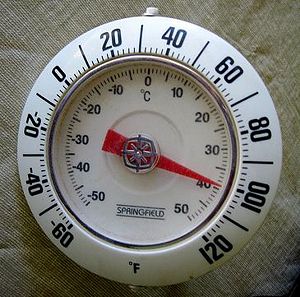Fahrenheit (unit): Difference between revisions
imported>Daniel Mietchen (#REDIRECT Fahrenheit and Rankine temperatures) |
mNo edit summary |
||
| (11 intermediate revisions by 4 users not shown) | |||
| Line 1: | Line 1: | ||
{{subpages}} | |||
{{dambigbox|Fahrenheit (unit)|Fahrenheit}} | |||
{{Image|Thermometer Dial.jpg|right|300px|A thermometer dial displaying temperatures in degrees Celsius and in degrees Fahrenheit.}} | |||
The '''Fahrenheit''' scale is a [[temperature]] scale, used mainly in the [[United States of America/Definition|U.S.]]<ref>[https://www.worldatlas.com/articles/countries-that-use-fahrenheit.html Countries that use Fahrenheit] in The World Atlas 2018 online, last access 12/3/2022</ref>, named after the [[German]] physicist [[Daniel Gabriel Fahrenheit]] (1686 − 1736), who proposed it in 1724. The symbol of a degree Fahrenheit is '''°F''' and the scale has now been largely replaced by the [[Celsius]] scale although it is still in use for non-scientific purposes in the [[United States of America]]. | |||
In the Fahrenheit scale, the [[melting point]] of [[water]] (i.e., ice) at an atmospheric [[pressure]] of 101.325 [[kilo|k]][[Pascal (unit)|Pa]] is 32 degrees Fahrenheit (°F) and the [[normal boiling point]] of water is 212 °F, placing those two reference points exactly 180 °F apart. [[Absolute zero]] in the Fahrenheit scale is −459.67 °F. | |||
For comparison, in the [[Celsius]] scale, the melting point of water is 0 degrees [[Celsius (unit)|Celsius]] (°F) and the normal boiling point of water is 100 °C, placing those two reference points exactly 100 °C apart. Absolute zero in the Celsius scale is 273.15 °C. | |||
A temperature interval of 1 degree Celsius is equal to an interval of 1.8 degrees Fahrenheit. | |||
The different temperature scales ([[Kelvin (unit)|kelvin]], [[Celsius (unit)|Celsius]], Fahrenheit and [[Rankine (unit)|Rankine]]) can be converted into each other. (See the [[Temperature conversion]] article.) | |||
== Usage == | |||
The Fahrenheit scale was the primary temperature standard for climatic, industrial and medical purposes in most English-speaking countries until the 1960s. In the late 1960's and 1970's, the Celsius (formerly ''Centigrade'') scale was adopted by most of these countries as part of the standardizing process called [[metrication]]. | |||
Only in the United States, [[Belize]]<ref>[http://www.hydromet.gov.bz/ Belize National Meteorological Service] Accessed May 24, 2009</ref> and perhaps a few other countries do the Fahrenheit and [[Rankine (unit)|Rankine]] systems continue to be used, and mainly for non-scientific use. Most other countries have adopted Celsius as the primary scale in all use, although Fahrenheit continues to be the scale of preference for a minority of people in the [[United Kingdom]], particularly when referring to summer temperatures. Many [[Great Britain|British]] people are conversant with both the Celsius and Fahrenheit temperature scales. | |||
==References== | |||
{{reflist}}[[Category:Suggestion Bot Tag]] | |||
Latest revision as of 06:01, 15 August 2024
The Fahrenheit scale is a temperature scale, used mainly in the U.S.[1], named after the German physicist Daniel Gabriel Fahrenheit (1686 − 1736), who proposed it in 1724. The symbol of a degree Fahrenheit is °F and the scale has now been largely replaced by the Celsius scale although it is still in use for non-scientific purposes in the United States of America.
In the Fahrenheit scale, the melting point of water (i.e., ice) at an atmospheric pressure of 101.325 kPa is 32 degrees Fahrenheit (°F) and the normal boiling point of water is 212 °F, placing those two reference points exactly 180 °F apart. Absolute zero in the Fahrenheit scale is −459.67 °F.
For comparison, in the Celsius scale, the melting point of water is 0 degrees Celsius (°F) and the normal boiling point of water is 100 °C, placing those two reference points exactly 100 °C apart. Absolute zero in the Celsius scale is 273.15 °C.
A temperature interval of 1 degree Celsius is equal to an interval of 1.8 degrees Fahrenheit.
The different temperature scales (kelvin, Celsius, Fahrenheit and Rankine) can be converted into each other. (See the Temperature conversion article.)
Usage
The Fahrenheit scale was the primary temperature standard for climatic, industrial and medical purposes in most English-speaking countries until the 1960s. In the late 1960's and 1970's, the Celsius (formerly Centigrade) scale was adopted by most of these countries as part of the standardizing process called metrication.
Only in the United States, Belize[2] and perhaps a few other countries do the Fahrenheit and Rankine systems continue to be used, and mainly for non-scientific use. Most other countries have adopted Celsius as the primary scale in all use, although Fahrenheit continues to be the scale of preference for a minority of people in the United Kingdom, particularly when referring to summer temperatures. Many British people are conversant with both the Celsius and Fahrenheit temperature scales.
References
- ↑ Countries that use Fahrenheit in The World Atlas 2018 online, last access 12/3/2022
- ↑ Belize National Meteorological Service Accessed May 24, 2009
